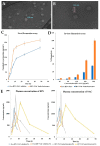Liposome-Derived Nanosystems for the Treatment of Behavioral and Neurodegenerative Diseases: The Promise of Niosomes, Transfersomes, and Ethosomes for Increased Brain Drug Bioavailability
- PMID: 37895895
- PMCID: PMC10610493
- DOI: 10.3390/ph16101424
Liposome-Derived Nanosystems for the Treatment of Behavioral and Neurodegenerative Diseases: The Promise of Niosomes, Transfersomes, and Ethosomes for Increased Brain Drug Bioavailability
Abstract
Psychiatric and neurodegenerative disorders are amongst the most prevalent and debilitating diseases, but current treatments either have low success rates, greatly due to the low permeability of the blood-brain barrier, and/or are connected to severe side effects. Hence, new strategies are extremely important, and here is where liposome-derived nanosystems come in. Niosomes, transfersomes, and ethosomes are nanometric vesicular structures that allow drug encapsulation, protecting them from degradation, and increasing their solubility, permeability, brain targeting, and bioavailability. This review highlighted the great potential of these nanosystems for the treatment of Alzheimer's disease, Parkinson's disease, schizophrenia, bipolar disorder, anxiety, and depression. Studies regarding the encapsulation of synthetic and natural-derived molecules in these systems, for intravenous, oral, transdermal, or intranasal administration, have led to an increased brain bioavailability when compared to conventional pharmaceutical forms. Moreover, the developed formulations proved to have neuroprotective, anti-inflammatory, and antioxidant effects, including brain neurotransmitter level restoration and brain oxidative status improvement, and improved locomotor activity or enhancement of recognition and working memories in animal models. Hence, albeit being relatively new technologies, niosomes, transfersomes, and ethosomes have already proven to increase the brain bioavailability of psychoactive drugs, leading to increased effectiveness and decreased side effects, showing promise as future therapeutics.
Keywords: Alzheimer’s disease; Parkinson’s; anxiety; brain bioavailability; depression; ethosomes; intranasal; niosomes; schizophrenia; transfersomes.
Conflict of interest statement
The authors declare no conflict of interest.
Figures






References
-
- GBD 2019 Mental Disorders Collaborators Global, Regional, and National Burden of 12 Mental Disorders in 204 Countries and Territories, 1990–2019: A Systematic Analysis for the Global Burden of Disease Study 2019. Lancet Psychiatry. 2022;9:137–150. doi: 10.1016/S2215-0366(21)00395-3. - DOI - PMC - PubMed
-
- Prince M. Oxford Textbook of Community Mental Health. Oxford University Press; Oxford, UK: 2010. The Global Burden of Mental Disorder. Chapter 7.
Publication types
LinkOut - more resources
Full Text Sources

